Unit2 I'll help to clean up the city parks.单元教学案(4课时)
文档属性
| 名称 | Unit2 I'll help to clean up the city parks.单元教学案(4课时) | 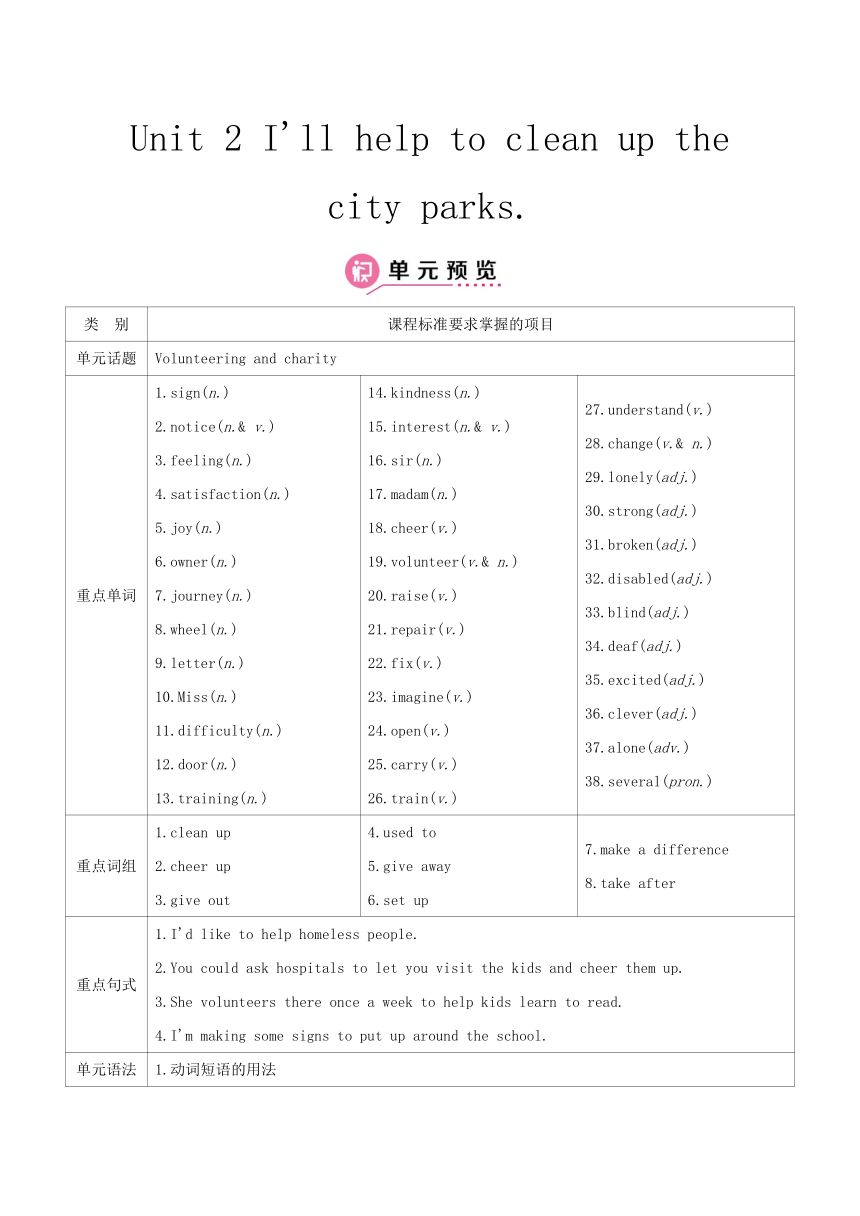 | |
| 格式 | docx | ||
| 文件大小 | 69.1KB | ||
| 资源类型 | 教案 | ||
| 版本资源 | 人教新目标(Go for it)版 | ||
| 科目 | 英语 | ||
| 更新时间 | 2021-04-14 12:49:34 | ||
图片预览

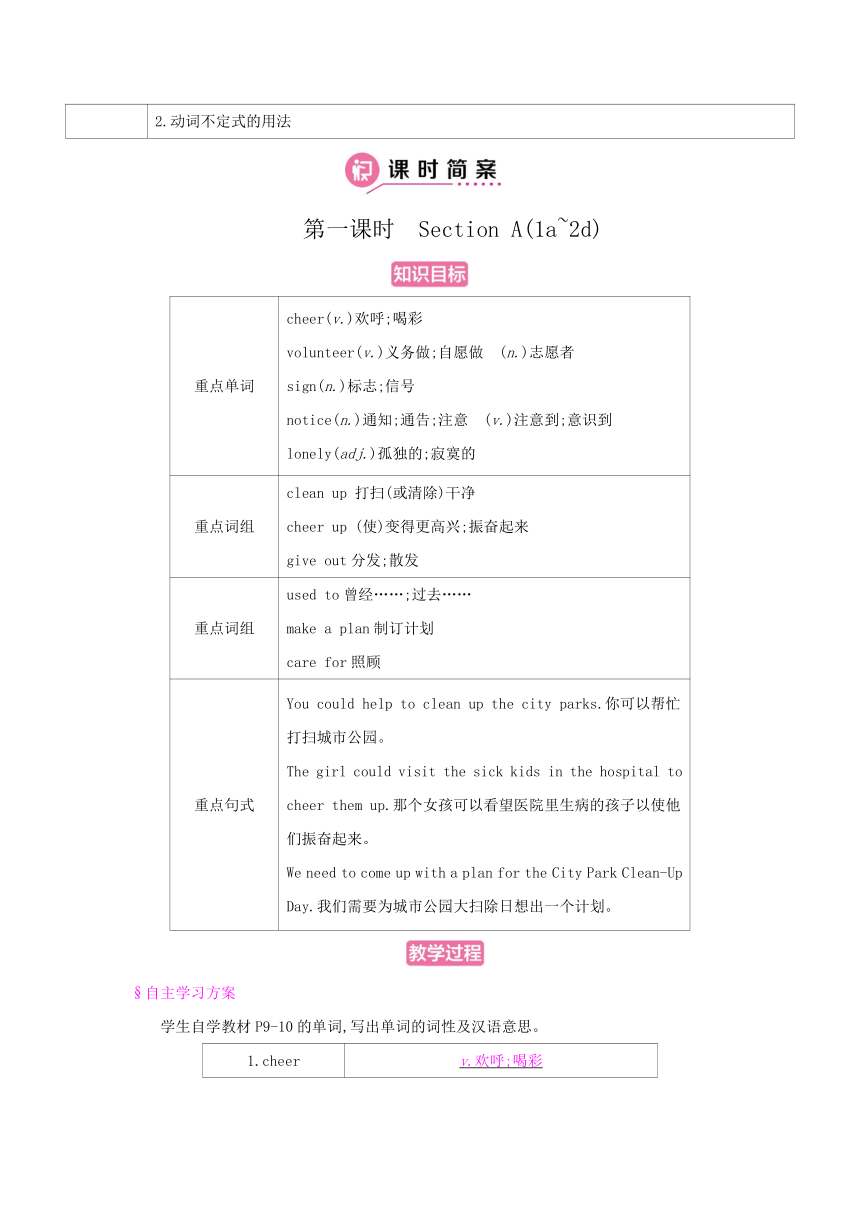
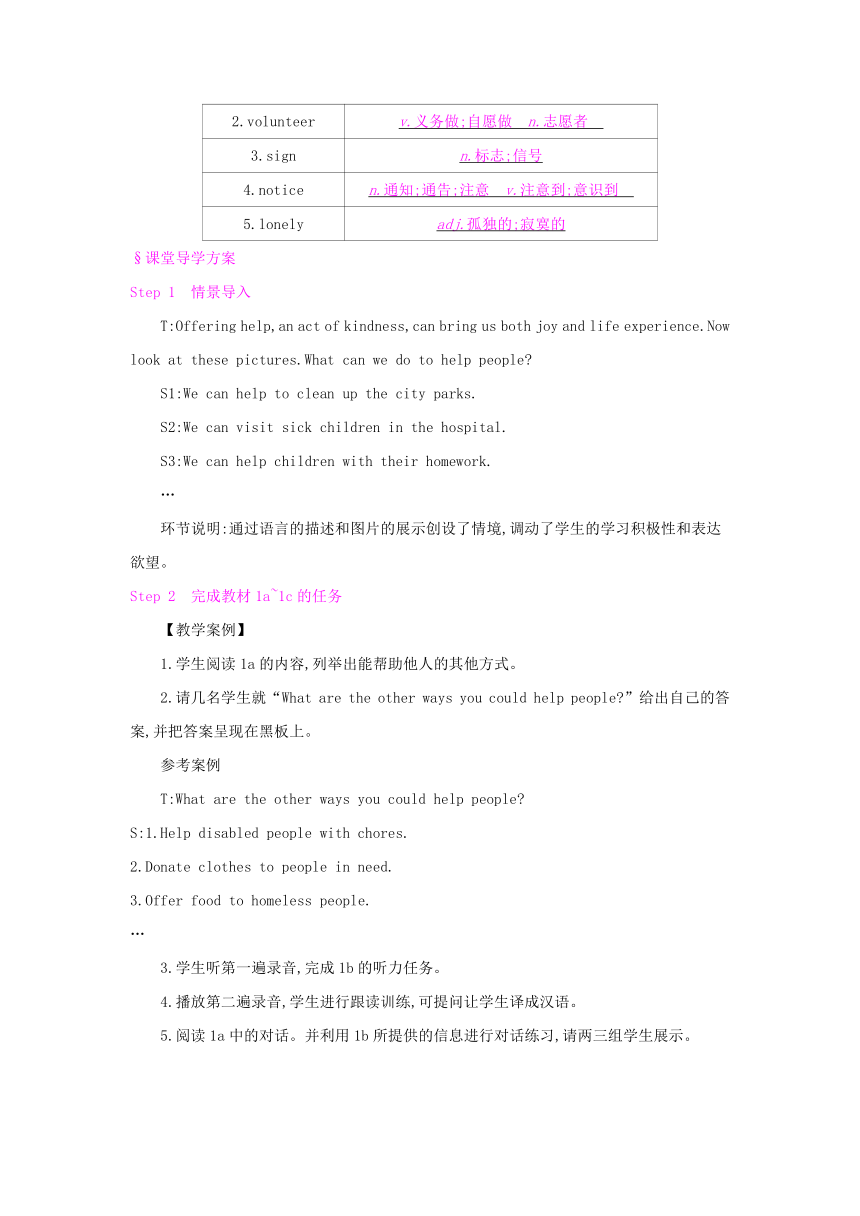
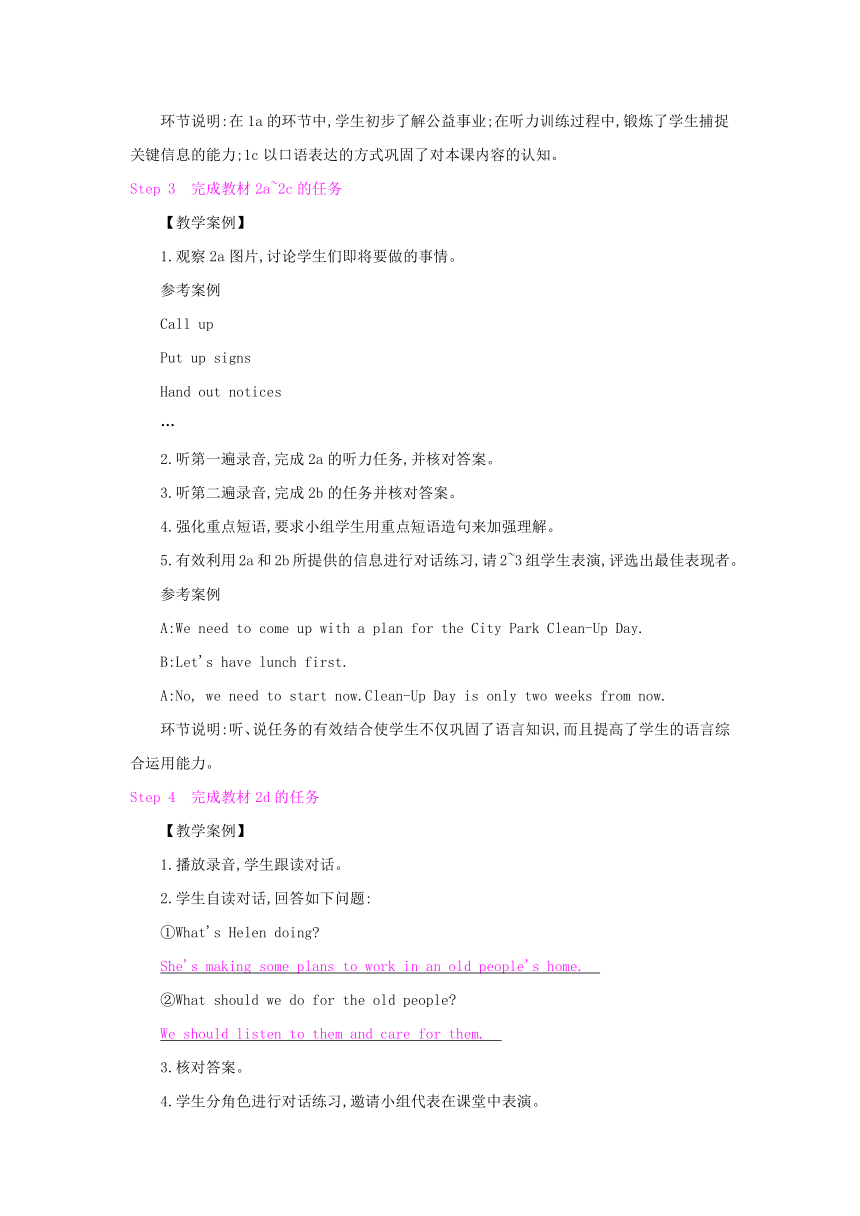
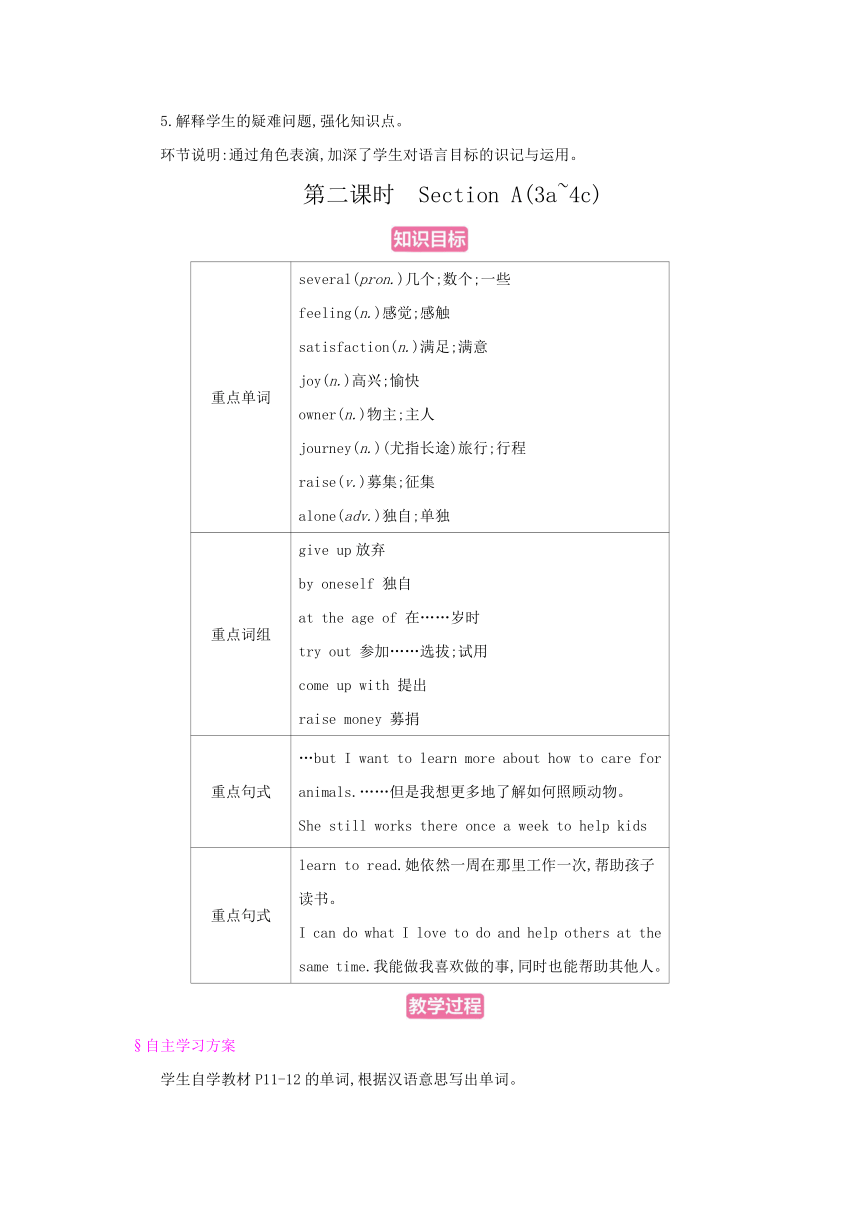
文档简介
Unit 2 I'll help to clean up the city parks.
类 别
课程标准要求掌握的项目
单元话题
Volunteering and charity
重点单词
1.sign(n.)
2.notice(n.& v.)
3.feeling(n.)
4.satisfaction(n.)
5.joy(n.)
6.owner(n.)
7.journey(n.)
8.wheel(n.)
9.letter(n.)
10.Miss(n.)
11.difficulty(n.)
12.door(n.)
13.training(n.)
14.kindness(n.)
15.interest(n.& v.)
16.sir(n.)
17.madam(n.)
18.cheer(v.)
19.volunteer(v.& n.)
20.raise(v.)
21.repair(v.)
22.fix(v.)
23.imagine(v.)
24.open(v.)
25.carry(v.)
26.train(v.)
27.understand(v.)
28.change(v.& n.)
29.lonely(adj.)
30.strong(adj.)
31.broken(adj.)
32.disabled(adj.)
33.blind(adj.)
34.deaf(adj.)
35.excited(adj.)
36.clever(adj.)
37.alone(adv.)
38.several(pron.)
重点词组
1.clean up
2.cheer up
3.give out
4.used to
5.give away
6.set up
7.make a difference
8.take after
重点句式
1.I'd like to help homeless people.
2.You could ask hospitals to let you visit the kids and cheer them up.
3.She volunteers there once a week to help kids learn to read.
4.I'm making some signs to put up around the school.
单元语法
1.动词短语的用法
2.动词不定式的用法
第一课时 Section A(1a~2d)
重点单词
cheer(v.)欢呼;喝彩
volunteer(v.)义务做;自愿做 (n.)志愿者
sign(n.)标志;信号
notice(n.)通知;通告;注意 (v.)注意到;意识到
lonely(adj.)孤独的;寂寞的
重点词组
clean up 打扫(或清除)干净
cheer up (使)变得更高兴;振奋起来
give out分发;散发
重点词组
used to曾经……;过去……
make a plan制订计划
care for照顾
重点句式
You could help to clean up the city parks.你可以帮忙打扫城市公园。
The girl could visit the sick kids in the hospital to cheer them up.那个女孩可以看望医院里生病的孩子以使他们振奋起来。
We need to come up with a plan for the City Park Clean-Up Day.我们需要为城市公园大扫除日想出一个计划。
§自主学习方案
学生自学教材P9-10的单词,写出单词的词性及汉语意思。
1.cheer
v.欢呼;喝彩
2.volunteer
v.义务做;自愿做 n.志愿者?
3.sign
n.标志;信号
4.notice
n.通知;通告;注意 v.注意到;意识到?
5.lonely
adj.孤独的;寂寞的
§课堂导学方案
Step 1 情景导入
T:Offering help,an act of kindness,can bring us both joy and life experience.Now look at these pictures.What can we do to help people?
S1:We can help to clean up the city parks.
S2:We can visit sick children in the hospital.
S3:We can help children with their homework.
…
环节说明:通过语言的描述和图片的展示创设了情境,调动了学生的学习积极性和表达欲望。
Step 2 完成教材1a~1c的任务
【教学案例】
1.学生阅读1a的内容,列举出能帮助他人的其他方式。
2.请几名学生就“What are the other ways you could help people?”给出自己的答案,并把答案呈现在黑板上。
参考案例
T:What are the other ways you could help people?
S:1.Help disabled people with chores.
2.Donate clothes to people in need.
3.Offer food to homeless people.
…
3.学生听第一遍录音,完成1b的听力任务。
4.播放第二遍录音,学生进行跟读训练,可提问让学生译成汉语。
5.阅读1a中的对话。并利用1b所提供的信息进行对话练习,请两三组学生展示。
环节说明:在1a的环节中,学生初步了解公益事业;在听力训练过程中,锻炼了学生捕捉关键信息的能力;1c以口语表达的方式巩固了对本课内容的认知。
Step 3 完成教材2a~2c的任务
【教学案例】
1.观察2a图片,讨论学生们即将要做的事情。
参考案例
Call up
Put up signs
Hand out notices
…
2.听第一遍录音,完成2a的听力任务,并核对答案。
3.听第二遍录音,完成2b的任务并核对答案。
4.强化重点短语,要求小组学生用重点短语造句来加强理解。
5.有效利用2a和2b所提供的信息进行对话练习,请2~3组学生表演,评选出最佳表现者。
参考案例
A:We need to come up with a plan for the City Park Clean-Up Day.
B:Let's have lunch first.
A:No, we need to start now.Clean-Up Day is only two weeks from now.
环节说明:听、说任务的有效结合使学生不仅巩固了语言知识,而且提高了学生的语言综合运用能力。
Step 4 完成教材2d的任务
【教学案例】
1.播放录音,学生跟读对话。
2.学生自读对话,回答如下问题:
①What's Helen doing?
She's making some plans to work in an old people's home.?
②What should we do for the old people?
We should listen to them and care for them.?
3.核对答案。
4.学生分角色进行对话练习,邀请小组代表在课堂中表演。
5.解释学生的疑难问题,强化知识点。
环节说明:通过角色表演,加深了学生对语言目标的识记与运用。
第二课时 Section A(3a~4c)
重点单词
several(pron.)几个;数个;一些
feeling(n.)感觉;感触
satisfaction(n.)满足;满意
joy(n.)高兴;愉快
owner(n.)物主;主人
journey(n.)(尤指长途)旅行;行程
raise(v.)募集;征集
alone(adv.)独自;单独
重点词组
give up放弃
by oneself 独自
at the age of 在……岁时
try out 参加……选拔;试用
come up with 提出
raise money 募捐
重点句式
…but I want to learn more about how to care for animals.……但是我想更多地了解如何照顾动物。
She still works there once a week to help kids
重点句式
learn to read.她依然一周在那里工作一次,帮助孩子读书。
I can do what I love to do and help others at the same time.我能做我喜欢做的事,同时也能帮助其他人。
§自主学习方案
学生自学教材P11-12的单词,根据汉语意思写出单词。
1.几个;数个;一些
several
2.感觉;感触
feeling
3.满足;满意
satisfaction
4.高兴;愉快
joy
5.物主;主人
owner
6.(尤指长途)旅行;行程
journey
7.募集;征集
raise
8.独自;单独
alone
§课堂导学方案
Step 1 情景导入
T:More and more volunteers make contributions to our society.
Questions:
1.Do you want to be a volunteer?
2.How can we help others?
S:…
T:Here are two students Mario and Mary.They like to help people in their free time.
环节说明:带着问题来学习短文,不仅达到了导入新课的目的,同时引发学生积极思考自己作为志愿者应该做些什么,使学生体会到奉献的意义。
Step 2 完成教材3a~3c的任务
【教学案例】
1.播放短文录音,全体学生跟读。请几位学生朗读短文(可每人读一段),教师及时纠正语音问题。
2.学生默读短文,熟知大意,回答3a的问题:What do Mario and Mary volunteer to do?并核对答案:Mario volunteers at an animal hospital and Mary helps kids learn to read.
3.完成3b的内容,请学生回答问题。
4.完成3c,用动词不定式填空并完成句子。
5.请学生总结不定式的用法,教师给予补充。
环节说明:通过短文的学习,进行了思想教育的渗透:发扬奉献精神,争当志愿者。
Step 3 完成教材Grammar Focus的任务
【教学案例】
1.全体学生齐读语法句子。
2.两位学生配合,一位学生朗读英文句子,另一位学生把句子译成汉语。
3.学生脱离教材,完成以下句子练习。
①I'd like to help homeless people.(帮助无家可归的人)?
②She decided to try out for a volunteer.(尝试做)?
③She volunteers there once a week to help kids learn to read.(帮助孩子们学习阅读)?
④I'm making some signs to put up around the school.(张贴)?
4.总结动词不定式。
构成:to+do(动词原形)
用法:
①用作宾语(v.+to do)
I want to buy a computer.
②用作宾语补足语。(v.+sb.+to do)
want sb. to do wish sb. to do
get sb. to do order sb. to do
ask sb. to do like sb. to do
would like sb. to do help sb. to do
③用作宾语补足语不带to的情况:
使役动词:let,make,have
感官动词:see,watch,hear,feel
④用作状语
He came to show me his new CD player.(目的)
The boy was too frightened to move.(结果)
环节说明:通过句子练习和语法总结进一步巩固所学知识。
Step 4 完成教材4a~4c的任务
【教学案例】
1.学生完成4a的填空任务,核对答案,体会动词不定式的用法。
2.用动词的正确形式填空,核对答案,总结动词不定式所充当的句子成分。
3.学生根据自己的想法,用动词不定式补全句子。
环节说明:层层深入,深层次掌握语法知识。
第三课时 Section B(1a~1e)
重点单词
repair(v.)修理;修补
fix(v.)修理;安装
broken(adj.)破损的;残缺的
wheel(n.)车轮;轮子
重点词组
give away 捐赠
take after 像
fix up修理;装饰
be similar to 与……相似
重点句式
I've run out of it.我已经用完了。
I gave away my bike to a children's home.我把我的自行车捐赠给了儿童之家。
Jimmy fixes up broken bicycle parts, like wheels.吉米修理坏的自行车部件,如轮子。
§自主学习方案
学生自学教材P13的单词,写出单词的汉语意思、变形形式或相关短语。
1.repair
v. 修理,修补
2.fix
修理,装饰 fix up
3.broken
v. break
4.wheel
n. 车轮;轮子
§课堂导学方案
Step 1 情景导入
T:We all know that being a volunteer is a good way to help others.Everyone should help others in their own ways.
Questions:
1.Would you like to do something to help others in your free time?
2.What would you like to do?
Students:…
环节说明:课前的师生问答既回顾了上节课的内容又自然地导入了本节课,同时让学生知道助人为乐的道理。
Step 2 完成教材1a~1e的任务
【教学案例】
1.读1a的句子,请学生译成汉语,完成1a的匹配任务并核对答案。
2.学生完成1b的任务,请四名学生在黑板上写出答案。
参考案例
I gave away my bike to a children's home.
Mary takes after her mother.
The boy could fix up his bike at the age of ten.
We've run out of water.Let's buy some in the supermarket.
3.听第一遍录音,完成1c的排序任务并核对答案。
4.听第二遍录音,完成1d的判断正误。
5.再听录音,全班逐句跟读,随时请个别学生翻译句子。
6.脱离教材,学生根据听力内容,利用1b和1c所提供的信息进行对话表演。
环节说明:使语言知识目标实现于听力教学中,再通过对话练习加以巩固夯实,事半功倍。
第四课时 Section B(2a~Self Check)
重点单词
letter(n.)信;函
Miss(n.)女士;小姐
disabled(adj.)丧失能力的;有残疾的
blind(adj.)瞎的;失明的
deaf(adj.)聋的
imagine(v.)想象;设想
difficulty(n.)困难;难题
open(v.)开;打开
door(n.)门
carry(v.)拿;提;扛
train(v.)训练;培训
excited(adj.)激动的;兴奋的
training(n.)训练;培训
kindness(n.)仁慈;善良
clever(adj.)聪明的;聪颖的
understand(v.)理解;领会
change(v.& n.)变化;改变
interest n.兴趣;关注 v. 使感兴趣;使关注
sir(n.)先生
madam(n.)夫人;女士
重点词组
set up 建立
make a difference 影响;有作用
help out帮助
because of 因为
重点句式
Lucky makes a big difference to my life.Lucky对我的生活有很大的影响。
You see, I'm only able to have a “dog helper”
重点句式
because of your kindness!你看,就是因为你的善良我才拥有了一个“狗助手”!
Thank you again for changing my life.再次谢谢你改变了我的生活。
§自主学习方案
学生自学教材P14-16的单词,根据汉语写出单词。
1.信;函
letter
2.女士;小姐
Miss
3.瞎的;失明的
blind
4.聋的
deaf
5.想象;设想
imagine
6.困难;难题
difficulty
7.开;打开
open
8.门
door
9.拿;提;扛
carry
10.训练;培训
train
11.激动的;兴奋的
excited
12.训练;培训
training
13.仁慈;善良
kindness
14.聪明的;聪颖的
clever
15.理解;领会
understand
16.变化;改变
change
17.兴趣;关注 使感兴趣;使关注
interest
18.先生
sir
19.夫人;女士
madam
§课堂导学方案
Step 1 情景导入
T:Animals are our good friends.We should care for the animals around us.
Questions:
1.Do you have any pet animals?
2.In what way do you think dogs are able to help people?
S:…
环节说明:由问题导入短文的学习,激发学生的学习兴趣,达到良好的学习效果。
Step 2 完成教材2a~2e的任务
【教学案例】
1.学生小组讨论2a中的问题,以小组为单位发表各自的见解。
2.播放2b的短文录音,全班跟读。请几位学生分段朗读短文,老师要注意学生的语音,给予必要的纠正。
3.学生默读短文,熟知大意,回答2b的问题,学生讨论答案。
4.学生自读短文,完成2c中词性的判定,请八位学生在黑板上书写句子,统一纠正错误。
5.完成教材中2d的任务,请学生朗读句子。
6.以小组为单位,讨论2e的问题,派代表向全班汇报讨论结果。
参考案例
In what other ways do you think dogs are able to help people?
What other animals can we train to help people?
环节说明:以短文为载体,巩固了目标知识点,同时学习判定词性来帮助理解单词的含义。
Step 3 完成教材3a~3b的任务
【教学案例】
1.学生以小组合作的方式完成3a的任务,派代表把讨论结果在黑板上展示。
参考案例
Cleaning up the city parks
Visiting sick children in the hospital
Teaching kids in an after-school program
…
2.学生完成3b的写作训练并请3名学生朗读所写文章,学生们提出修改意见。
环节说明:通过学生训练在实践中应用语言知识。
Step 4 完成教材Self Check的任务
【教学案例】
1.学生填入适当的动词来完成任务1,鼓励学生填入尽可能多的动词。
2.学生完成任务2并大声朗读短文。
环节说明:全面检测本单元的知识,做到查漏补缺。
类 别
课程标准要求掌握的项目
单元话题
Volunteering and charity
重点单词
1.sign(n.)
2.notice(n.& v.)
3.feeling(n.)
4.satisfaction(n.)
5.joy(n.)
6.owner(n.)
7.journey(n.)
8.wheel(n.)
9.letter(n.)
10.Miss(n.)
11.difficulty(n.)
12.door(n.)
13.training(n.)
14.kindness(n.)
15.interest(n.& v.)
16.sir(n.)
17.madam(n.)
18.cheer(v.)
19.volunteer(v.& n.)
20.raise(v.)
21.repair(v.)
22.fix(v.)
23.imagine(v.)
24.open(v.)
25.carry(v.)
26.train(v.)
27.understand(v.)
28.change(v.& n.)
29.lonely(adj.)
30.strong(adj.)
31.broken(adj.)
32.disabled(adj.)
33.blind(adj.)
34.deaf(adj.)
35.excited(adj.)
36.clever(adj.)
37.alone(adv.)
38.several(pron.)
重点词组
1.clean up
2.cheer up
3.give out
4.used to
5.give away
6.set up
7.make a difference
8.take after
重点句式
1.I'd like to help homeless people.
2.You could ask hospitals to let you visit the kids and cheer them up.
3.She volunteers there once a week to help kids learn to read.
4.I'm making some signs to put up around the school.
单元语法
1.动词短语的用法
2.动词不定式的用法
第一课时 Section A(1a~2d)
重点单词
cheer(v.)欢呼;喝彩
volunteer(v.)义务做;自愿做 (n.)志愿者
sign(n.)标志;信号
notice(n.)通知;通告;注意 (v.)注意到;意识到
lonely(adj.)孤独的;寂寞的
重点词组
clean up 打扫(或清除)干净
cheer up (使)变得更高兴;振奋起来
give out分发;散发
重点词组
used to曾经……;过去……
make a plan制订计划
care for照顾
重点句式
You could help to clean up the city parks.你可以帮忙打扫城市公园。
The girl could visit the sick kids in the hospital to cheer them up.那个女孩可以看望医院里生病的孩子以使他们振奋起来。
We need to come up with a plan for the City Park Clean-Up Day.我们需要为城市公园大扫除日想出一个计划。
§自主学习方案
学生自学教材P9-10的单词,写出单词的词性及汉语意思。
1.cheer
v.欢呼;喝彩
2.volunteer
v.义务做;自愿做 n.志愿者?
3.sign
n.标志;信号
4.notice
n.通知;通告;注意 v.注意到;意识到?
5.lonely
adj.孤独的;寂寞的
§课堂导学方案
Step 1 情景导入
T:Offering help,an act of kindness,can bring us both joy and life experience.Now look at these pictures.What can we do to help people?
S1:We can help to clean up the city parks.
S2:We can visit sick children in the hospital.
S3:We can help children with their homework.
…
环节说明:通过语言的描述和图片的展示创设了情境,调动了学生的学习积极性和表达欲望。
Step 2 完成教材1a~1c的任务
【教学案例】
1.学生阅读1a的内容,列举出能帮助他人的其他方式。
2.请几名学生就“What are the other ways you could help people?”给出自己的答案,并把答案呈现在黑板上。
参考案例
T:What are the other ways you could help people?
S:1.Help disabled people with chores.
2.Donate clothes to people in need.
3.Offer food to homeless people.
…
3.学生听第一遍录音,完成1b的听力任务。
4.播放第二遍录音,学生进行跟读训练,可提问让学生译成汉语。
5.阅读1a中的对话。并利用1b所提供的信息进行对话练习,请两三组学生展示。
环节说明:在1a的环节中,学生初步了解公益事业;在听力训练过程中,锻炼了学生捕捉关键信息的能力;1c以口语表达的方式巩固了对本课内容的认知。
Step 3 完成教材2a~2c的任务
【教学案例】
1.观察2a图片,讨论学生们即将要做的事情。
参考案例
Call up
Put up signs
Hand out notices
…
2.听第一遍录音,完成2a的听力任务,并核对答案。
3.听第二遍录音,完成2b的任务并核对答案。
4.强化重点短语,要求小组学生用重点短语造句来加强理解。
5.有效利用2a和2b所提供的信息进行对话练习,请2~3组学生表演,评选出最佳表现者。
参考案例
A:We need to come up with a plan for the City Park Clean-Up Day.
B:Let's have lunch first.
A:No, we need to start now.Clean-Up Day is only two weeks from now.
环节说明:听、说任务的有效结合使学生不仅巩固了语言知识,而且提高了学生的语言综合运用能力。
Step 4 完成教材2d的任务
【教学案例】
1.播放录音,学生跟读对话。
2.学生自读对话,回答如下问题:
①What's Helen doing?
She's making some plans to work in an old people's home.?
②What should we do for the old people?
We should listen to them and care for them.?
3.核对答案。
4.学生分角色进行对话练习,邀请小组代表在课堂中表演。
5.解释学生的疑难问题,强化知识点。
环节说明:通过角色表演,加深了学生对语言目标的识记与运用。
第二课时 Section A(3a~4c)
重点单词
several(pron.)几个;数个;一些
feeling(n.)感觉;感触
satisfaction(n.)满足;满意
joy(n.)高兴;愉快
owner(n.)物主;主人
journey(n.)(尤指长途)旅行;行程
raise(v.)募集;征集
alone(adv.)独自;单独
重点词组
give up放弃
by oneself 独自
at the age of 在……岁时
try out 参加……选拔;试用
come up with 提出
raise money 募捐
重点句式
…but I want to learn more about how to care for animals.……但是我想更多地了解如何照顾动物。
She still works there once a week to help kids
重点句式
learn to read.她依然一周在那里工作一次,帮助孩子读书。
I can do what I love to do and help others at the same time.我能做我喜欢做的事,同时也能帮助其他人。
§自主学习方案
学生自学教材P11-12的单词,根据汉语意思写出单词。
1.几个;数个;一些
several
2.感觉;感触
feeling
3.满足;满意
satisfaction
4.高兴;愉快
joy
5.物主;主人
owner
6.(尤指长途)旅行;行程
journey
7.募集;征集
raise
8.独自;单独
alone
§课堂导学方案
Step 1 情景导入
T:More and more volunteers make contributions to our society.
Questions:
1.Do you want to be a volunteer?
2.How can we help others?
S:…
T:Here are two students Mario and Mary.They like to help people in their free time.
环节说明:带着问题来学习短文,不仅达到了导入新课的目的,同时引发学生积极思考自己作为志愿者应该做些什么,使学生体会到奉献的意义。
Step 2 完成教材3a~3c的任务
【教学案例】
1.播放短文录音,全体学生跟读。请几位学生朗读短文(可每人读一段),教师及时纠正语音问题。
2.学生默读短文,熟知大意,回答3a的问题:What do Mario and Mary volunteer to do?并核对答案:Mario volunteers at an animal hospital and Mary helps kids learn to read.
3.完成3b的内容,请学生回答问题。
4.完成3c,用动词不定式填空并完成句子。
5.请学生总结不定式的用法,教师给予补充。
环节说明:通过短文的学习,进行了思想教育的渗透:发扬奉献精神,争当志愿者。
Step 3 完成教材Grammar Focus的任务
【教学案例】
1.全体学生齐读语法句子。
2.两位学生配合,一位学生朗读英文句子,另一位学生把句子译成汉语。
3.学生脱离教材,完成以下句子练习。
①I'd like to help homeless people.(帮助无家可归的人)?
②She decided to try out for a volunteer.(尝试做)?
③She volunteers there once a week to help kids learn to read.(帮助孩子们学习阅读)?
④I'm making some signs to put up around the school.(张贴)?
4.总结动词不定式。
构成:to+do(动词原形)
用法:
①用作宾语(v.+to do)
I want to buy a computer.
②用作宾语补足语。(v.+sb.+to do)
want sb. to do wish sb. to do
get sb. to do order sb. to do
ask sb. to do like sb. to do
would like sb. to do help sb. to do
③用作宾语补足语不带to的情况:
使役动词:let,make,have
感官动词:see,watch,hear,feel
④用作状语
He came to show me his new CD player.(目的)
The boy was too frightened to move.(结果)
环节说明:通过句子练习和语法总结进一步巩固所学知识。
Step 4 完成教材4a~4c的任务
【教学案例】
1.学生完成4a的填空任务,核对答案,体会动词不定式的用法。
2.用动词的正确形式填空,核对答案,总结动词不定式所充当的句子成分。
3.学生根据自己的想法,用动词不定式补全句子。
环节说明:层层深入,深层次掌握语法知识。
第三课时 Section B(1a~1e)
重点单词
repair(v.)修理;修补
fix(v.)修理;安装
broken(adj.)破损的;残缺的
wheel(n.)车轮;轮子
重点词组
give away 捐赠
take after 像
fix up修理;装饰
be similar to 与……相似
重点句式
I've run out of it.我已经用完了。
I gave away my bike to a children's home.我把我的自行车捐赠给了儿童之家。
Jimmy fixes up broken bicycle parts, like wheels.吉米修理坏的自行车部件,如轮子。
§自主学习方案
学生自学教材P13的单词,写出单词的汉语意思、变形形式或相关短语。
1.repair
v. 修理,修补
2.fix
修理,装饰 fix up
3.broken
v. break
4.wheel
n. 车轮;轮子
§课堂导学方案
Step 1 情景导入
T:We all know that being a volunteer is a good way to help others.Everyone should help others in their own ways.
Questions:
1.Would you like to do something to help others in your free time?
2.What would you like to do?
Students:…
环节说明:课前的师生问答既回顾了上节课的内容又自然地导入了本节课,同时让学生知道助人为乐的道理。
Step 2 完成教材1a~1e的任务
【教学案例】
1.读1a的句子,请学生译成汉语,完成1a的匹配任务并核对答案。
2.学生完成1b的任务,请四名学生在黑板上写出答案。
参考案例
I gave away my bike to a children's home.
Mary takes after her mother.
The boy could fix up his bike at the age of ten.
We've run out of water.Let's buy some in the supermarket.
3.听第一遍录音,完成1c的排序任务并核对答案。
4.听第二遍录音,完成1d的判断正误。
5.再听录音,全班逐句跟读,随时请个别学生翻译句子。
6.脱离教材,学生根据听力内容,利用1b和1c所提供的信息进行对话表演。
环节说明:使语言知识目标实现于听力教学中,再通过对话练习加以巩固夯实,事半功倍。
第四课时 Section B(2a~Self Check)
重点单词
letter(n.)信;函
Miss(n.)女士;小姐
disabled(adj.)丧失能力的;有残疾的
blind(adj.)瞎的;失明的
deaf(adj.)聋的
imagine(v.)想象;设想
difficulty(n.)困难;难题
open(v.)开;打开
door(n.)门
carry(v.)拿;提;扛
train(v.)训练;培训
excited(adj.)激动的;兴奋的
training(n.)训练;培训
kindness(n.)仁慈;善良
clever(adj.)聪明的;聪颖的
understand(v.)理解;领会
change(v.& n.)变化;改变
interest n.兴趣;关注 v. 使感兴趣;使关注
sir(n.)先生
madam(n.)夫人;女士
重点词组
set up 建立
make a difference 影响;有作用
help out帮助
because of 因为
重点句式
Lucky makes a big difference to my life.Lucky对我的生活有很大的影响。
You see, I'm only able to have a “dog helper”
重点句式
because of your kindness!你看,就是因为你的善良我才拥有了一个“狗助手”!
Thank you again for changing my life.再次谢谢你改变了我的生活。
§自主学习方案
学生自学教材P14-16的单词,根据汉语写出单词。
1.信;函
letter
2.女士;小姐
Miss
3.瞎的;失明的
blind
4.聋的
deaf
5.想象;设想
imagine
6.困难;难题
difficulty
7.开;打开
open
8.门
door
9.拿;提;扛
carry
10.训练;培训
train
11.激动的;兴奋的
excited
12.训练;培训
training
13.仁慈;善良
kindness
14.聪明的;聪颖的
clever
15.理解;领会
understand
16.变化;改变
change
17.兴趣;关注 使感兴趣;使关注
interest
18.先生
sir
19.夫人;女士
madam
§课堂导学方案
Step 1 情景导入
T:Animals are our good friends.We should care for the animals around us.
Questions:
1.Do you have any pet animals?
2.In what way do you think dogs are able to help people?
S:…
环节说明:由问题导入短文的学习,激发学生的学习兴趣,达到良好的学习效果。
Step 2 完成教材2a~2e的任务
【教学案例】
1.学生小组讨论2a中的问题,以小组为单位发表各自的见解。
2.播放2b的短文录音,全班跟读。请几位学生分段朗读短文,老师要注意学生的语音,给予必要的纠正。
3.学生默读短文,熟知大意,回答2b的问题,学生讨论答案。
4.学生自读短文,完成2c中词性的判定,请八位学生在黑板上书写句子,统一纠正错误。
5.完成教材中2d的任务,请学生朗读句子。
6.以小组为单位,讨论2e的问题,派代表向全班汇报讨论结果。
参考案例
In what other ways do you think dogs are able to help people?
What other animals can we train to help people?
环节说明:以短文为载体,巩固了目标知识点,同时学习判定词性来帮助理解单词的含义。
Step 3 完成教材3a~3b的任务
【教学案例】
1.学生以小组合作的方式完成3a的任务,派代表把讨论结果在黑板上展示。
参考案例
Cleaning up the city parks
Visiting sick children in the hospital
Teaching kids in an after-school program
…
2.学生完成3b的写作训练并请3名学生朗读所写文章,学生们提出修改意见。
环节说明:通过学生训练在实践中应用语言知识。
Step 4 完成教材Self Check的任务
【教学案例】
1.学生填入适当的动词来完成任务1,鼓励学生填入尽可能多的动词。
2.学生完成任务2并大声朗读短文。
环节说明:全面检测本单元的知识,做到查漏补缺。
同课章节目录
- Unit 1 What's the matter?
- Section A
- Section B
- Unit 2 I'll help to clean up the city parks.
- Section A
- Section B
- Unit 3 Could you please clean your room?
- Section A
- Section B
- Unit 4 Why don't you talk to your parents?
- Section A
- Section B
- Unit 5 What were you doing when the rainstorm came
- Section A
- Section B
- Review of Units 1-5
- Unit 6 An old man tried to move the mountains.
- Section A
- Section B
- Unit 7 What's the highest mountain in the world?
- Section A
- Section B
- Unit 8 Have you read Treasure Island yet?
- Section A
- Section B
- Unit 9 Have you ever been to a museum?
- Section A
- Section B
- Unit 10 I've had this bike for three years.
- Section A
- Section B
